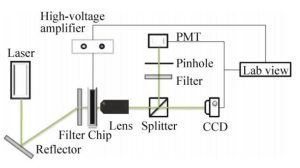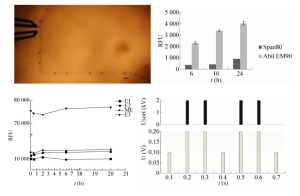Experiment Name: Application of Power Amplifier in Microfluidic Chip Testing
Research direction: microfluidic chip testing
Experimental content: In this experiment, the metabolite amino acid was taken as the research object, and the characteristics of the micro-droplets embedding amino acids were studied.
Purpose of the test: Through the research on the characteristics of micro-droplets embedding amino acids, lay the foundation for the droplet microfluidic chip system in amino acid detection, high-throughput screening of corresponding production strains, and directed evolution transformation.
Test equipment: laser, focusing objective lens, high-speed camera, optical filter, photomultiplier tube, data acquisition card, SLA-HV-2000 high-voltage amplifier, Mitos pressure pump, silicon wafer, SU-8 2025 optical glue, plasma cleaning machine, uniform Glue machine, heating table, UV lithography machine, microfluidic chip, PDMS.
Experiment procedure:
(1) Construction of droplet microfluidic chip integrated control system;
The laser emits a wavelength of 532 nm, and the emitted laser light passes through a filter to remove clutter, and then focuses on the detection point of the microfluidic chip. When the micro-droplets embedded with fluorescent substances pass through the detection point, they are excited to generate fluorescence, which is focused by the focusing objective lens and then reaches the beam splitter.
A part of the fluorescence is transmitted to the high-speed camera through the spectroscope to monitor the flow of the micro-droplets in real time; the other part of the fluorescence is received by the photomultiplier tube (PMT) through the filter and converted into a voltage signal by the data acquisition Card acquisition and analysis by LabVIEW software. The high-voltage amplifier is used for the deflection of micro-droplets. When the detection signal of the target micro-droplets exceeds the threshold set for sorting, the analysis software applies a deflection voltage to the micro-droplets through the high-voltage amplifier and the electrodes on the microfluidic chip. Due to the action of dielectrophoretic force, the target micro-droplets will be deflected and flow to the sorting channel to be collected.
Test Results:
(1) The diameter of the generated micro-droplets is controllable, the size is uniform and stable, and the reaction system in the micro-droplets is small, which can save a lot of reagents;
(2) Micro-droplets can exist stably for a long time, meeting the time requirements of reagent reaction or cell culture;
(3) The embedded matter of the micro-droplets exists stably in the test micro-droplets, there is no cross-contamination between the micro-droplets, and it will not affect the fluorescence detection and sorting of the micro-droplets in the later stage;
(4) The screening throughput of microdroplets can reach 600 per minute. These experiments provided the possibility of high-throughput screening for the detection and analysis of cell secretions such as enzymes and amino acids and the screening of corresponding production strains, and laid the foundation for the application of droplet microfluidic chips in directed evolution.
The effectiveness of the amplifier in this experiment: Applying a deflection voltage to the micro-droplets for the deflection of the micro-droplets.
The reason why you choose this amplifier: The bandwidth and magnification just meet the requirements, and the test results are stable.






